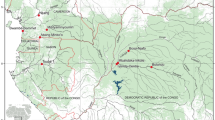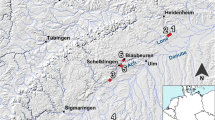Abstract
From where did the early inhabitants of the Badagry coastal area of southwestern Nigeria originate? Has the area been occupied from “ancient times,” as claimed by oral traditions? What was the nature of the environment and subsistence of these early inhabitants? Excavations at Apa, west of Badagry, provided answers to these questions. A radiocarbon date of 2670 ± 90 bp showed that human occupation there is at least 3000 years old, and implied occupation during the Late Stone Age. The occupation was in two phases: a prehistoric phase, during which Apa site 1 (Ap1) was occupied, and an historic phase, with occupation of Apa site 2 (Ap2). Sedimentological and archaeological data also showed that the environment at the beginning of occupation was similar to today. The presence of a groundstone axe, charred palm kernels, and charcoal at the Ap1 site is interpreted to imply the clearing and burning of vegetation, probably preparatory to planting and the exploitation of oil palm (Elaeis guineensis) from about 2670 ± 90 bp.
D'où sont venus les premiers habitants de la région côtiere Badagry du sud-ouest du Nigeria? Est-il vrai que la région a été occupé depuis les temps anciennes, comme confirme les traditions orales? Quelle étaient la nature de l'environnement et du subsistence de ces habitants préhistoriques? Des fouilles archéologiques à Apa, a l'ouest de Badagry, ont fourni des réponses nécessaires à ces questions. Un date radiocarbone de 2670 ± 90 bp a montré que les activités humaines de ce site date au moins de 3000 années, qui indique que l'occupation des habitants à c'endroit étais durant la periode de l'Age de la Pierre Recent. L'occupation de cette region était en deux phases: un phase prehistorique, la période pendant lequelle le site d'Apa 1 (Ap1) était occupé, et la phase historique, qui a marqué l'occupation du deuxième site d'Apa 2 (Ap2). Les données de la sedimentologie et de l'archéologie ont aussi montrent que l'environnement au commencement d'occupation était similaire de nos jours. On pense que la presence d'un hache “groundstone,” de l'amande de palmier et du charbon à la site d'Ap1 indiques la déstruction de la vegetation, preparant probablement la terre pour la semence et l'exploitation du l'huile de palme (Elaeis guineensis) d'environ de 2670 ± 90 bp.
Similar content being viewed by others
REFERENCES CITED
Adeduntan, J. (1985). Early glass technology of Ife. West African Journal of Archaeology 15: 165–172.
Adejuwon, J. O. (1975). Soil mapping in the coastal zone of western Nigeria. Nigerian Geographical Journal 18(1): 57–68.
Agbaje-Williams, B. (1989). Archaeological reconnaissance of Ipapo Ile, Kwara State, Nigeria: An interim report. West African Journal of Archaeology 19: 21–36.
Aileman, C. U. (1984). Quaternary Deposits of Inogi, Badagry Local Government Area of Lagos State, Unpublished BSc Dissertation, University of Ibadan, Ibadan, Nigeria.
Alabi, R. A. (1996). Archaeological reconnaissance of the Badagry coastal area, southwestern Nigeria. West African Journal of Archaeology 26(1): 88–102.
Alabi, R. A. (1998). An Environmental Archaeological Study of the Coastal Region of Southwestern Nigeria, With Emphasis on the Badagry Area, PhD Dissertation, University of Ibadan, Ibadan, Nigeria.
Aleru, J. O. (1988). International Institute of Tropical Agriculture Pottery: An Ethnoarchaeological Appraisal-Based on Materials From the Excavated Mound at Adesina-Oja Village (Square C4), MSc Dissertation, University of Ibadan, Ibadan, Nigeria.
Andah, B.W., and Anozie, F. N. (1981). Preliminary report on the prehistoric site of Afikpo, Imo State, Nigeria. West African Journal of Archaeology 10: 83–102.
Avoseh, T. (1938). A Short History of Badagry, Ile Ofu Printers, Lagos, Nigeria.
Ballouche, A., and Neumann, K. (1995). A new contribution to the Holocene vegetation history of the West African Sahel: Pollen from Oursi, Burkina Faso and charcoal from three sites in northeast Nigeria. Vegetation History and Archaeobotany 4: 31–39.
Breunig, P., Neumann, K., and Van Neer, W. (1996). New research on the Holocene settlement and environment of the Chad basin in Nigeria. African Archaeological Review 13(2): 111–145.
Connah, G. (1981). Three Thousand Years in Africa: Man and His Environment in the Lake Chad Region of Nigeria, Cambridge University Press, London.
Fatunsin, A. K. (1996). Ifetedo: A Late Stone Age site in the forest region of southwestern Nigeria.West African Journal of Archaeology 26(1): 71–87.
Iversen, J. (1956). Forest clearance in the Late Stone Age. Scientific American 194(5): 36–41.
Keay, R. W. J. (1959). An Outline of Nigerian Vegetation, Department of Forestry Research, Ibadan, Nigeria.
MacDonald, K. C. (1997). Korounkorokale revisited: The Pays Mande and theWest African microlithic technocomplex. African Archaeological Review 14(3): 161–200.
Maley, J. (1993). The climatic and vegetational history of the equatorial regions of Africa during the upper Quaternary. In Shaw, T., Sinclair, P., and Okpoko, A. (eds.), The Archaeology of Africa: Food, Metals and Towns, Routledge, London, pp. 43–52.
Oyelaran, P. A. (1991). Archaeological and Palaeoenvironmental Investigations in Iffe-Ijumu Area of Kwara State, Nigeria, PhD Dissertation, University of Ibadan, Ibadan, Nigeria.
Oyelaran, P. A. (1998). Early settlement and archaeological sequence of northeast Yorubaland. African Archaeological Review 15(1): 65–79.
Paradis, G. (1977). Observations sur l'holocene recent du sud Benin (ex-sud Dahomey). Bulletin de l'Association Sénégalaise pour l'Etude du Quaternaire Africain 51: 49–73.
Pastouret, L., Chamley, H., Duplesy, G., and Thiede, L. (1979). Late Quaternary climatic changes in western tropical Africa deduced from deep-sea sedimentation off Niger Delta. Oceanological Acta 1(2): 217–232.
Petit-Maire, N. (1980). Holocene biogeographical variations along the northwestern African coast (28–19ºN): Palaeoclimatic implications. Palaeoecology of Africa 12: 365–367.
Rossignol-Strick, M., and Duzer, D. (1979). West African vegetation and climate since 22,500 BP from deep-sea cores palynology. Pollen et Spores XXI(1/2): 105–134.
Salzmann, U., and Waller, M. (1998). The Holocene vegetational history of the Nigerian Sahel based on multiple pollen profiles. Review of Palaeobotany and Palynology 100: 39–72.
Shaw, T. (1977). Unearthing Igbo-Ukwu, Oxford University Press, Ibadan, Nigeria.
Shaw, T., and Daniels, S. G. H. (1984). Excavations at Iwo Eleru, Ondo State, Nigeria (Monograph 14). West African Journal of Archaeology, Ibadan.
Sowunmi, M. A. (1981a). Late Quaternary environmental changes in Nigeria. Pollen et Spores 23(1): 125–148.
Sowunmi, M. A. (1981b). Aspects of Late Quaternary vegetational changes inWest Africa. Journal of Biogeography 8: 457–474.
Sowunmi, M. A. (1985). The beginnings of agriculture in West Africa: Botanical evidence. Current Anthropology 26: 127–129.
Stahl, A. B. (1985). Reinvestigation of Kintampo 6 rock shelter, Ghana: Implications for the nature of culture change. African Archaeological Review 3: 117–150.
Stahl, A. B. (1993). Intensification in theWest African Late Stone Age: A view from central Ghana. In Shaw, T., Sinclair, P., Andah, B., and Okpoko, A. (eds.), The Archaeology of Africa: Food, Metals and Towns, Routledge, London, pp. 261–273.
Talbot, M. R. (1981). Holocene changes in tropical wind intensity and rainfall: Evidence from southern Ghana. Quaternary Research 16: 201–220.
Talbot, M. R., and Delibrias, G. (1980). A new Pleistocene-Holocene water-level curve for Lake Bosumtwi, Ghana. Earth and Planetary Science Letters 47(3): 336–344.
Talbot, M. R., Livingstone, D. A., Palmer, P. G., Maley, J., Melack, J., Delibrias, G., and Gulliksen, S. (1984). Preliminary results from sediment cores from Lake Bosumtwi, Ghana. Palaeoecology of Africa 16: 173–192.
Tastet, J. P. (1975). Les formations sedimentaires Quaternaires à actuelles du littoral du Dahomey. Bulletin de l'Association S´en´egalaise pour l'Etude du Quaternaire Africain 46: 21–44.
Usoro, E. J. (1977). Coastal Development in Lagos Area, PhD Dissertation, University of Ibadan, Ibadan, Nigeria.
York, R. N. (1972). Cowries as type fossils in Ghanaian archaeology. West African Journal of Archaeology 2: 93–101.
Author information
Authors and Affiliations
Rights and permissions
About this article
Cite this article
Alabi, R.A. Environment and Subsistence of the Early Inhabitants of Coastal Southwestern Nigeria. African Archaeological Review 19, 183–201 (2002). https://doi.org/10.1023/A:1021259003743
Issue Date:
DOI: https://doi.org/10.1023/A:1021259003743




